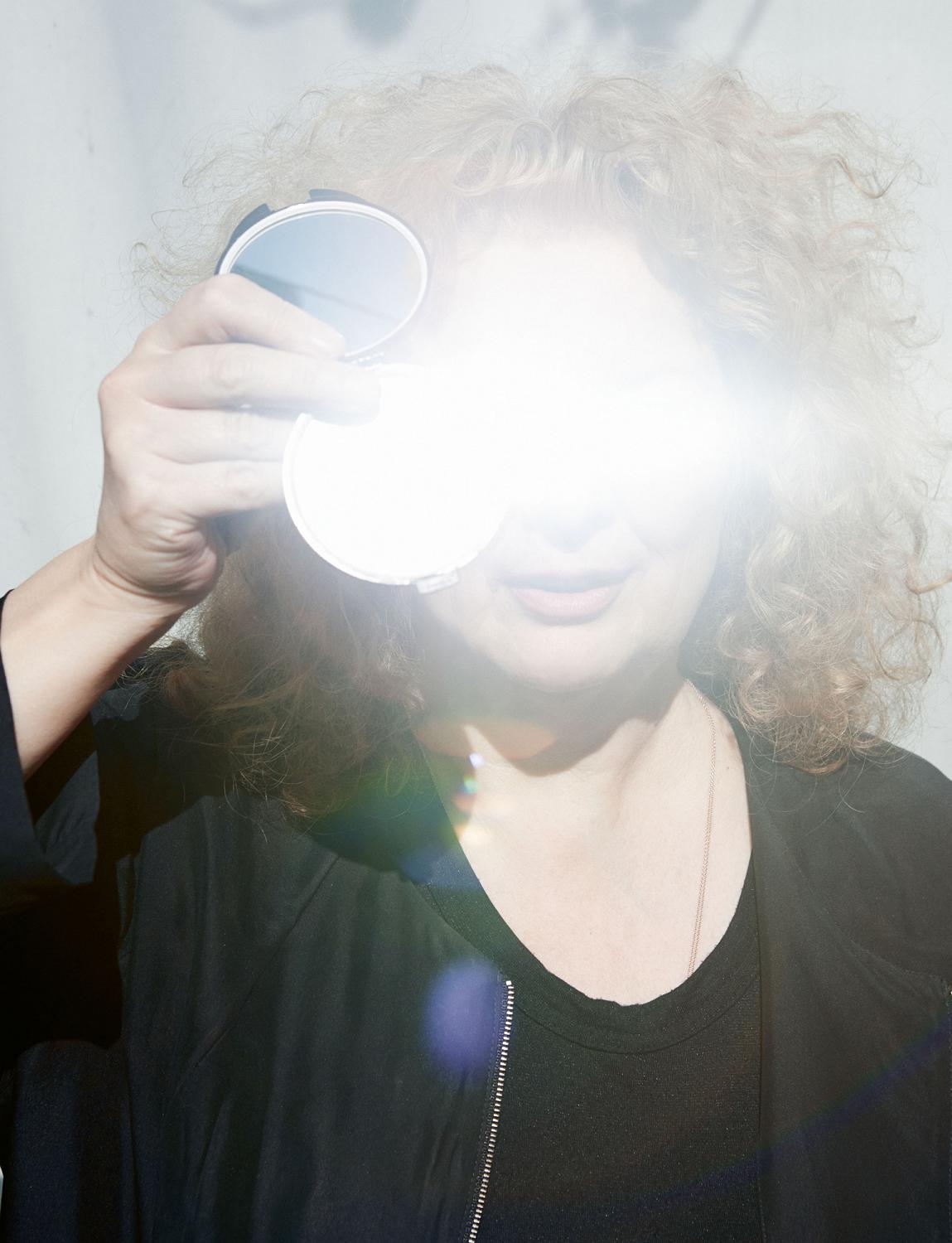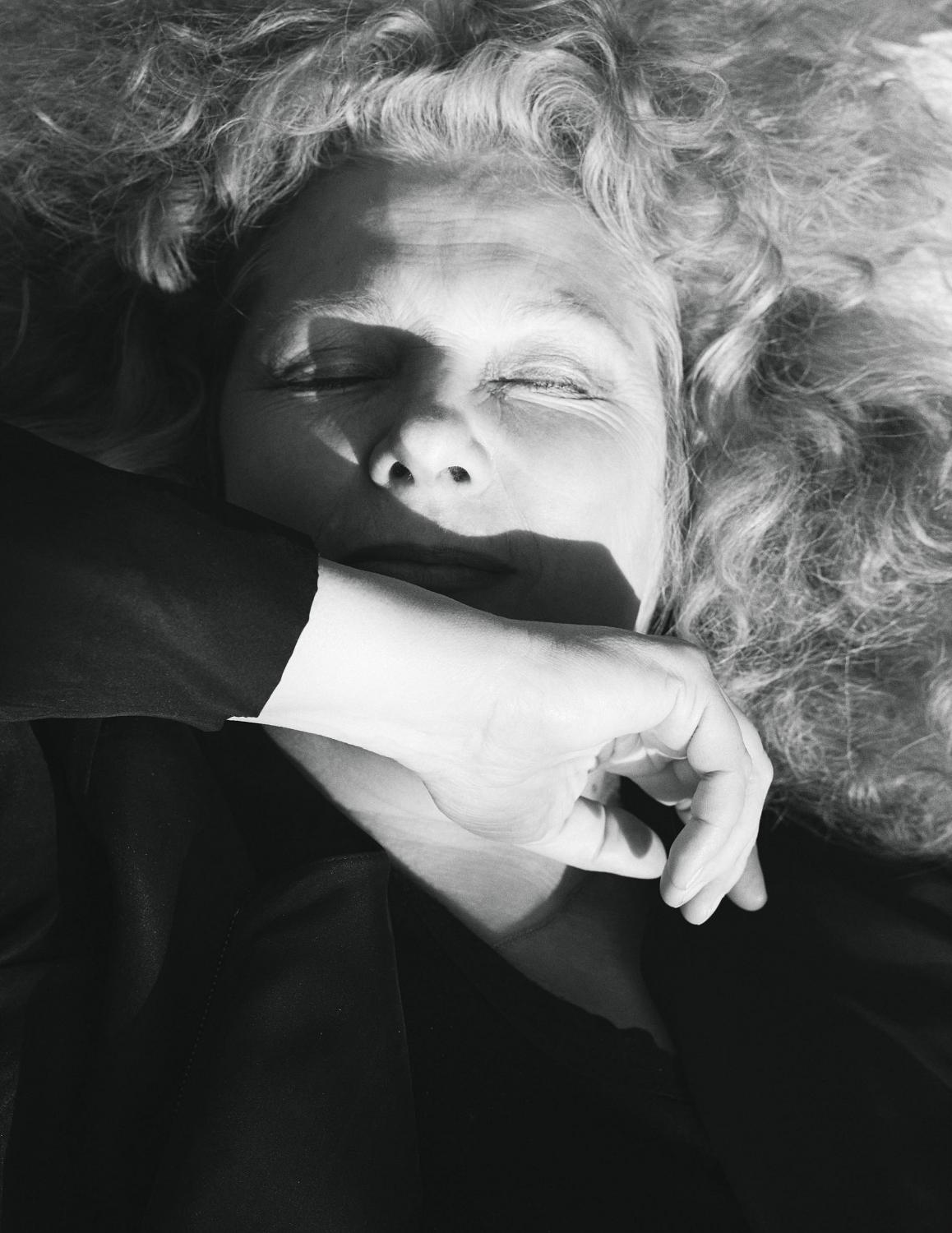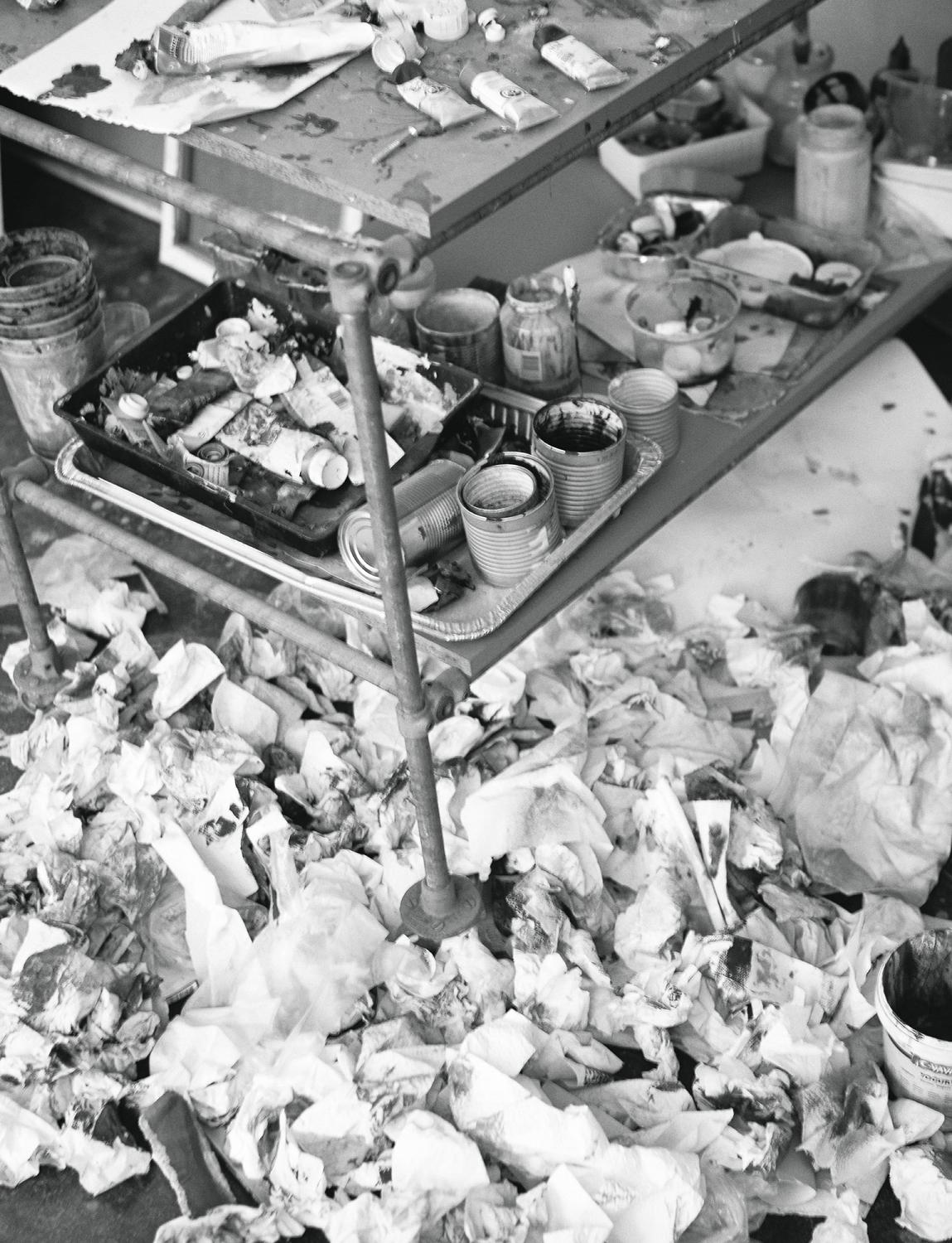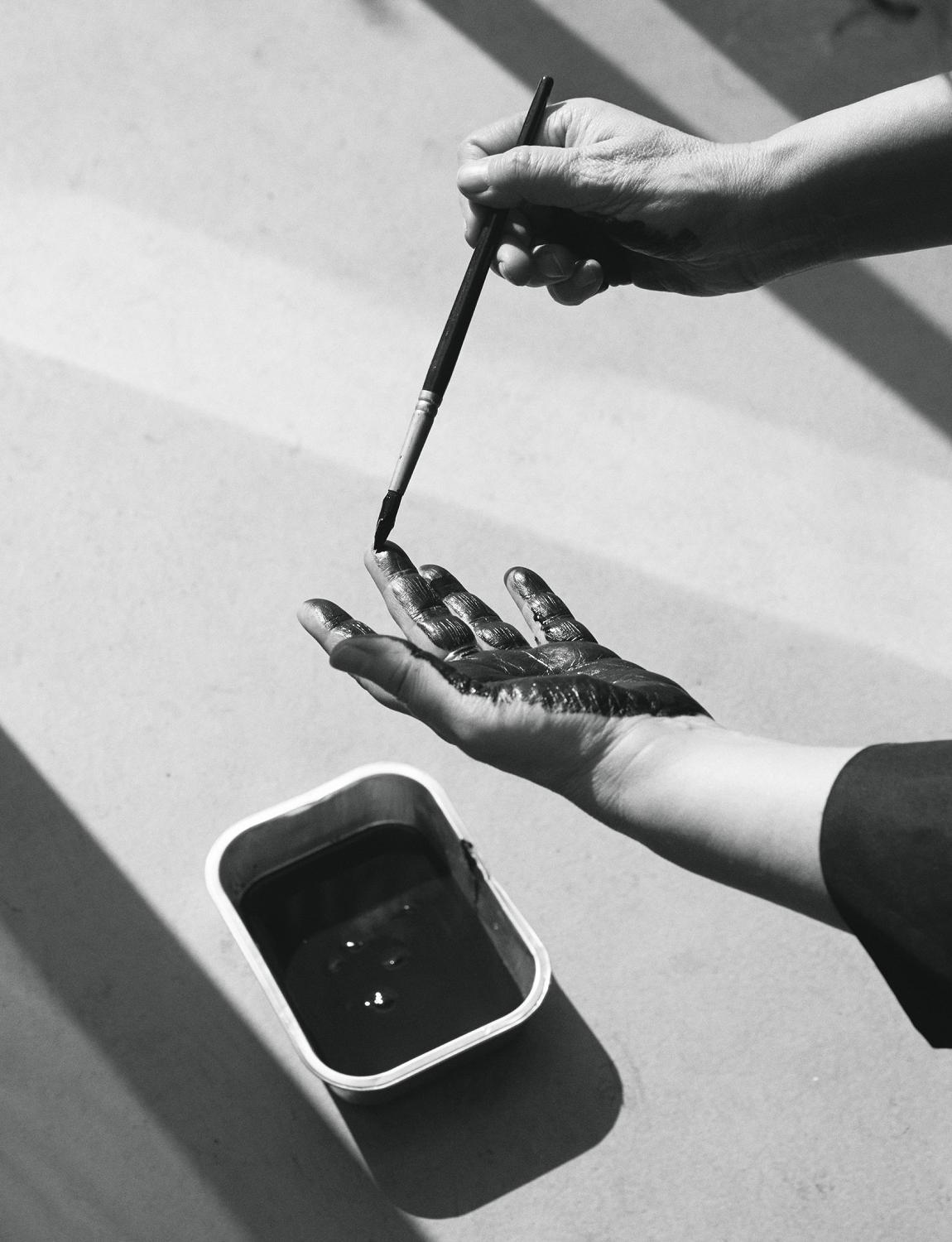Marlene
Dumas
Inside the studio of the world’s most expensive female painter

The Dutch artist Marlene Dumas insists she’s not an activist, but her provocative, unnervingly intimate portraiture runs the gamut of race, sexuality, deformity and every other complexity of being human. People get in the way for Marlene, though, at least during the work day: the 61-year-old likes to be alone in her Amsterdam studio with just photographs and press clippings for company. But once the painting’s done, Dumas is always up for a big glass of wine – she grew up on a vineyard in South Africa – and a hearty discussion about art. She also does an excellent Lucian Freud impersonation.
In 2008, her work became the most expensive by a living female artist, but Marlene isn’t motivated by the market. She prefers giving her work away to friends.
This summer, visitors to the State Hermitage Museum in St Petersburg were greeted by a series of wash portraits of 16 men, many of them Russian and all of them gay, staring down from the wall. They included Nikolai Gogol, Pyotr Tchaikovsky and Sergei Diaghilev as well as Alan Turing, the British computer scientist and codebreaker who was chemically castrated for being homosexual. There was a Russian man whose eye had been gouged out in a brutal homophobic attack, and Leonard Matlovich, an American Vietnam War veteran. Underneath each image was a short, handwritten summary of the subject’s life. Matlovich’s included a quote from his tombstone: “When I was in the military, they gave me a medal for killing two men and a discharge for loving one.”
The series, entitled Great Men, is the work of the Dutch artist Marlene Dumas and a part of Manifesta 10, an itinerant contemporary-art biennale that this year landed in the Russian city. (Manifesta 9 took place in Genk, Belgium, in 2012.) Marlene admits she was reluctant to participate at first because of the anti-gay legislation passed in Russia last year. “I didn’t even want the trouble of thinking about whether I should do something there or not,” she says. “But then I started to look into the stories and tragedies of these people’s lives, and what I found was profoundly upsetting.” She hopes her portraits will provoke the homophobic to re-examine their prejudices. “If you don’t like gay people, I want the drawings to make you think, ‘What a stupid, horrible person I am.’”
Marlene has a knack for quiet subversion. Her art works its magic on you sotto voce. When I visited her in May at her studio in Amsterdam, where she’s lived for nearly 40 years since leaving her native South Africa at 23, the portraits were still hanging on the walls, about to be packed up and sent to St Petersburg. “She really intends to be a painter of our time, to relate to the global, political situation and what’s going on around us,” says Leontine Coelewij, the curator of a comprehensive retrospective of the artist’s work set to open at the Stedelijk Museum in Amsterdam this autumn before travelling to the Tate Modern in London and the Fondation Beyeler in Basel. It spans four decades and includes over 100 drawings and paintings.
For the most part, Marlene Dumas paints people – women, men, children, babies – zooming in on her figures and removing any background or context which might locate them in a time or place. Her portraits are emotionally charged, confrontational, unsettling and ambiguous. Some of her subjects stare directly at us, appearing to question us as much as we would wish to question them. Others seem oblivious to our presence, engaged in private pursuits such as masturbation or positioned with their backs turned. Many are naked. Few smile. Several are dead, mouths agape. If you think portrait painting is for artists who aim to flatter and please their subjects, you haven’t met Marlene.

For the series of photographic portraits Marlene posed for her fellow Amsterdammer, artist Viviane Sassen.
She is not interested in creating realistic likenesses but in exploring what she calls “the psychology of people”. She mostly paints from photographs: images cut out of newspapers and magazines, film stills, pictures culled from art history. She never uses live models. “I don’t want people in my studio,” she says. “I want to be alone when I paint.” Getting to know her subjects, she says, hinders rather than helps her, making her sensitive to what they will think of their representation on canvas, denying her the freedom of “the amoral touch”. She works quickly, without outlining her figures on paper or canvas beforehand, building them up instead with loose, fluid brush strokes that suggest form rather than detail it, and the spontaneity of her gestures sometimes takes her representations in a different direction to the one she originally imagined. “There is an element of play to what I do,” says Marlene, “where something suddenly appears from something else.”
While she is the very definition of a serious artist who thinks deeply about her work and tackles the most difficult subjects head on, in person, she’s tremendously welcoming and enormous fun. She loves to talk and laughs easily and often. Questions are answered by way of numerous diversions and anecdotes, many of which she finds deeply amusing. English is her second language (her native tongue is Afrikaans), and though she’s totally fluent, she often pauses to find the right word or correct the terms she’s just used, her speech inflected with the cadences of her homeland and accompanied by emphatic hand gestures.
There is a naughtiness to Marlene’s demeanour, a twinkle in her eye, and an almost childlike quality in her propensity to smile and giggle. Her dishevelled blonde curls are swept off her face into a bun that at all times seems on the verge of collapse. Her clothes – soft black trousers, matching jacket and crumpled white blouse – are probably chosen for comfort as much as style. When she’s not working, she admits, she does only what she likes, eschewing tasks she finds tiresome. “I don’t have any hobbies,” she says. “I don’t exercise. I don’t ride a bicycle. I don’t even like brushing my teeth.” Instead, she spends time in bed reading or watching movies (she singles out the Italian filmmaker Pier Paolo Pasolini and the German one Rainer Werner Fassbinder as personal heroes) or television – she signs off one email saying she’s off home to catch an interview with Hillary Clinton and then a documentary about gay rights in Russia. She also likes drinking wine: “I’ve drunk too much for a lot of my life,” she says. She’s a prolific writer, having produced many texts over the years about her work and that of other artists, which give a profound insight into her thinking. There’s no shortage of Marlene, if you go out and look for her.
One evening, we had a white-asparagus-themed dinner at a restaurant near her studio with Jolie van Leeuwen, her studio manager. Jolie is a distinguished curator who has worked with the artist for over two decades (“She was one of the warmest artists I’d ever met,” said Van Leeuwen, recalling her first encounter with Marlene). Talk turned to the art market and its rapidly escalating prices. “That has been the worst thing for art,” said Dumas, whose painting “The Visitor”, showing a group of women awaiting a customer in an Amsterdam brothel with their backs to the viewer, made £3.2 million at Sotheby’s in London in July 2008, setting a record for the artist at auction. “I do not want to be remembered for this,” she said. “I would like to be remembered for having done at least one good painting in my life.”
Rising art prices have led to a process known as “flipping”, in which buyers sell works not long after acquiring them in search of a quick profit. Marlene abhors the practice, not least because it makes keeping track of her paintings difficult. So she vets prospective purchasers, blacklisting speculators. “If you’ve got three paintings everyone wants, and I have to choose between collectors one of whom has just sold something, I prefer not to sell to that collector,” she explained. And the conversation turned back to art, not prices.
It’s probably her favourite pastime of all: discussing art, often with her students, late into the night over drinks. “Me and her, we’ve got into a few very interesting debates,” says the artist and Oscar-winning filmmaker Steve McQueen, who also lives in Amsterdam and met Dumas when they both taught at the artist-run school Ateliers ’63 (now called De Ateliers). “The thing I love about Marlene is that she’s not scared to share her opinion and she’s not scared to be wrong,” he says. “When we argue, either I learn about something or she does. Since we met, it’s always been a debate. It’s always been a conversation.”

Marlene’s studio is located in the De Pijp district of Amsterdam. Marlene takes gleeful pride in the messiness of her studio, where she’s made many of her famous paintings.
Marlene’s workspace consists of a series of interconnected rooms in two adjacent buildings in Amsterdam’s De Pijp district. On one side is her office; on the other is her studio, its floor littered with mounds of crumpled paper and tissues and piles of discarded rubber gloves. Numerous tables are covered with containers full of dirty brushes. The place is a mess. “When I started to get known, people would say, ‘Can we come and take pictures of you in your studio? You must have a beautiful studio.’ I would reply, ‘Not particularly,’” she says, giggling.
Family photographs, newspaper clippings and images of paintings by old masters such as Leonardo, Titian and Vermeer cover the walls of a small room next door. Dumas collects imagery of every kind, immersing herself in pictures she finds interesting. Cabinets storing her works on paper are everywhere. Books line the corridors. It is an Aladdin’s cave of images and texts relating to her life: a museum of Marlene Dumas.
It is here, surrounded by her things, that she often finds inspiration. She can go months without painting, and then suddenly an image preserved years earlier will inspire a work. In 2008, she was preparing for a major retrospective that toured the United States, stopping in Los Angeles and Houston as well as at the Museum of Modern Art in New York. “I was just rearranging some things, and this old article fell out of a folder,” she says, eyebrows lifting. It was illustrated with a photograph of Marilyn Monroe, dead and laid out on a slab in the morgue. “Right then, I was occupied with images of the dead, and as I was going to America, I thought: Here’s my American painting. I didn’t want to paint Marilyn Monroe, but things literally fall together like that sometimes.”
Marlene Dumas was born in South Africa in 1953 and raised on a wine farm in Kuils River, 25km east of Cape Town. She was brought up with two older brothers in a Protestant Afrikaans household. “We were taught to be caring towards those that had less than we did,” she says. Apartheid, however, was not discussed. “My father was still angry with the British who put the women and children of the Afrikaner farmers into concentration camps.” She was 12 when her father died and her oldest brother took over the farm. “After that, I started to notice how everyone seemed to talk politics in some way or another. In my late teens, apartheid was defended as a separate-but-equal development, where eventually everyone would have the same rights. People really did think that the white European settler and black indigenous cultures were too different to mix and that only trouble-seekers were dissatisfied and violent. The ones who protested were called terrorists and communists.” Then she went off to the University of Cape Town, “and the horrors of the system really became clear,” she says. “I didn’t know what to do. Apartheid was working.”
Shortly afterwards, Dumas left South Africa, armed with a bachelor’s degree in fine arts and a two-year bursary to study abroad. She’s returned only to visit family and friends. She moved to the Netherlands and attended Ateliers ’63, located in the city of Haarlem in those days. Her decision to leave her native country was an act of pragmatism more than protest, she says. “Some artists are activists, and that’s fantastic. But I am an artist. I’m not saying that to be a painter is a higher calling than to be a feminist or an activist; it’s more a statement of fact. I’ve been awarded honorary doctorates by universities in South Africa in 2010 and 2011, and I had to tell them, ‘I wasn’t here.’ I have extreme respect for those journalists and documentary photographers who did stay.”
Her first years in the Netherlands were tough. Although she enjoyed freedoms she’d never known back home – “As a woman, the fact that you could walk around late at night here and not be scared was amazing” – she was displaced, alone and often judged for being a white South African. “People in bars would tell me I should be shot,” she recalls. “And I would say, ‘I can’t help where I come from.’” She recounts a conversation with a black taxi driver in Amsterdam in her early years in the city: “After a friendly general talk, he asked me where I came from, and as I took too long to answer, he said, ‘Oh, no. When you take that long to answer, I know where you’re from!’”
Before moving to Europe, Dumas had imagined she’d find an exuberant counterculture and mix with creative types akin to her hero Pasolini. “But the ’60s were over. The Dutch were not at all flamboyant, and I was very disappointed. The art being made here, or at least the painting, wasn’t at all exciting, and I didn’t really understand the Dutch humour. It’s taken a while, but I have become very attached to Amsterdam, and I do find it beautiful.”
Leontine Coelewij is devoting an entire room at the Stedelijk to works produced by the artist during her early years in the Netherlands. One is a pencil drawing of a houseplant inscribed with the words “I won’t have a pot plant, they die on me.” “Marlene found a really bourgeois society when she came here, and it was really not for her,” says Coelewij. “This drawing especially is about what it’s like to be an outsider in this new country, with all these neat and tidy houses with their neat little plants.”

Marlene’s turning point came in 1984, when she was invited to participate in the Biennale of Sydney; her work was displayed alongside that of the late installation artist Mike Kelley from Los Angeles and the German painter Anselm Kiefer, who produces giant abstract canvases infused with the tragedies of his country’s history. “I had a very small room to myself,” she says, “and I showed a little bit of this and a little bit of that. It wasn’t very coherent, and I was unknown at that time. And nearby there were these vast pieces by those guys, and they looked so heroic. It made me realise that I wanted to compete a bit with the boys.” She started to paint portraits in oil on canvas, searching for her voice as an artist. “I always had an interest in the human form, but I didn’t think I had a new way of expressing it,” she says. “To call yourself an artist, I thought you had to contribute something new, just like a scientist who has to discover something.” A year later, she had her first solo show at the Amsterdam gallery run by Paul Andriesse, whose artist cousin Jan would later become her partner. (The couple have been together for nearly 30 years. Jan was born in Indonesia, though his family left when he was 6. Marlene describes their relationship as “not so conventional”.) The 11 large-scale portraits in that first Amsterdam show included representations of Sigmund Freud’s wife, Martha Bernays; Dumas’s grandmother; and the American poet Emily Dickinson.
In the intervening three decades, Dumas has painted people at stages ranging from the beginning of life to the end, experimenting with traditional formats from art history such as the nude and the funerary portrait and always exploring the question of what painting can do in an age of pervasive imagery. Her subjects have included terrorists, explicitly posed strippers and murder victims. She has often painted Christ, not as an otherworldly divinity but as a dying man, abandoned and alone.
“The newspaper is full of dead people,” she says of her frequent return to mortality. “And I want painting to be part of real life. I’m not Degas, painting pretty ballerinas. Every time we look at the news, there are much more horrible things than those I paint – like child soldiers in Africa. Painting is about exploring one’s fears, but also I feel that it can be beautiful somehow.”
Many of Dumas’s canvases have the power to unnerve their viewers, but one in particular is as disturbing today as it was when it was first exhibited more than 20 years ago. “The Painter” is based on a snapshot of Helena, Dumas and Jan Andriesse’s only child, taken while their daughter, then 3 or 4, was in the garden finger-painting. In it, she is naked, covered in the different colours she’s been using.
In the monumental painting that emerged, Helena, now nearly 2m high, is shown in a full frontal pose with a surly expression on her face. Her belly and torso are blue, recalling the discolouration that can occur on the skin after death and thus suggesting a mother’s unflinching depiction of the mortality of her own child. “Since Helena was born, the fear that something can happen to this child has been like nothing I’d ever known before,” explains Dumas. “That fear is definitely very much present in the painting.”
But there’s more. The girl’s left hand, covered in red as if it has been dipped in blood, suggests that the toddler has been involved in some murderous activity, as if Dumas is confronting her own child’s capacity for evil. It is a radical departure from traditional parental portraits of offspring. “I think if you bring this new person into the world and you don’t have that fear that they may do bad things, then there must be something wrong with you,” says Marlene.
The Museum of Modern Art decided against using a full image of the painting, however iconic, on its posters for her solo exhibition there in 2008 (they chose a close-up of part of the face instead). The director of another museum was troubled by the work because the toddler seemed angry. “I’m still surprised that ‘The Painter’ causes so much controversy. I would like to know how a painting that seems to be of such a simple thing can bother people to such an extent,” says Marlene. Helena is 25 now. “And she thinks it’s one of the best paintings I’ve done.”
Susan and Michael Hort live surrounded by art in their cavernous four-floor loft in New York’s TriBeCa. The couple have been collecting work by emerging artists for over two decades and now own around 3,000 pieces. A small selection decorates their home, while the rest stays in storage; the art is rehung annually. This year, pieces by the Scottish artist Jim Lambie, the American painter Jonas Wood and the English sculptor Thomas Houseago are carefully arranged in the generous spaces, along with a room of works on paper by the emerging Los Angeles artist Jon Pestoni.
“If you come back next year, you won’t find any of these same works,” says Michael Hort when I visit one afternoon in early summer. That’s not strictly true: the art in the couple’s bedroom includes one work that is never replaced. It is a portrait by Marlene Dumas of the Horts’ late daughter Rema, who died in 1995 of stomach cancer, aged 30. The couple had bought several works by Marlene early in her career, visited her in Europe regularly and “loved, loved, loved her work,” says Michael. Shortly after Rema died, Dumas asked them for a photograph of their daughter. Soon afterward, the couple received the portrait as an unexpected gift.
Jane Hamlyn of London’s Frith Street Gallery, who has held four exhibitions of her work since 1993, has also experienced Dumas’s generosity first-hand. “Once Marlene asked me for some photographs of my children, and a couple of years later when she was showing me around her exhibition at the Metropolitan Art Museum in Tokyo, we came across a huge wall with only two small paintings in the middle of it. One was of her daughter, Helena; the other was of my daughter, Scarlett. ‘It’s for you,’ she said.”
When we spoke in Amsterdam, Dumas was busy preparing for the Stedelijk retrospective. Her first solo exhibition in the Netherlands for over 20 years, it includes examples from numerous major cycles of work. Among them is a portrait of Osama bin Laden, originally shown in a 2011 Frith Street Gallery exhibition entitled Forsaken, accompanied here by a painting of the late al-Qaeda leader’s son Omar. “Bin Laden was also a father,” says Leontine Coelewij. “You would never think of him like that, but Marlene makes you do that.”
“There is usually a certain outrage that will trigger Dumas’s images,” says David Zwirner, the powerful gallerist with two spaces in New York and one in London. He started representing Marlene in 2008 after courting her for five years. “This is the engine that drives the meaning of much of her work and ultimately makes it so powerful, political and raw. You can’t really understand this unless you realise that apartheid, which was basically a fascist regime that wasn’t unlike the Nazis’ in many of their structures, wasn’t abolished in South Africa until the early ’90s. I think this is always with her and drives her moral compass.”
In 2010, for her first solo show at Zwirner’s West 19th Street gallery, Dumas painted a series of works based on the security wall built by Israel to separate itself from the Palestinian territories. With its focus on a specific time and place and identifiable architectural elements, the series was a major departure for Dumas, who showed multiple figures facing the wall, disempowered. “She could have made portraits for the rest of her life and done very well,” says Steve McQueen. “But she’s always been interested in searching. When you answer one question as an artist, another one arises. Her work is evolving; her art never stays still. That’s Marlene.”
But Dumas has her limits. “If something horrible happened to Helena, I would never paint that,” she says. Neither did she take pictures of her mother after her death. Instead, a massive portrait of her late parent as an elderly woman hangs in Dumas’s studio, looking down on her daughter as she works late into the night.
Cristina RuizA distinct and intelligent voice in arts writing who has interviewed Barbara Kruger, Rachel Whiteread, Catherine Opie and Shirin Neshat for The Gentlewoman, Cristina is the former editor of The Art Newspaper who has also contributed to Vanity Fair, the Financial Times, UK Vogue and The Sunday Times Magazine.…read more Portraits by
Viviane SassenDutch photographer Viviane Sassen grew up in Kenya before relocating to the Netherlands to study, firstly, fashion design in Arnhem and subsequently, photography at Hogeschool voor de Kunsten Utrecht. Viviane is now a highly decorated photographer, counting art prizes such as the Infinity Award from…read more
Photographic assistance: Hanneke van Leeuwen. Post-production: Thijme Breukers.